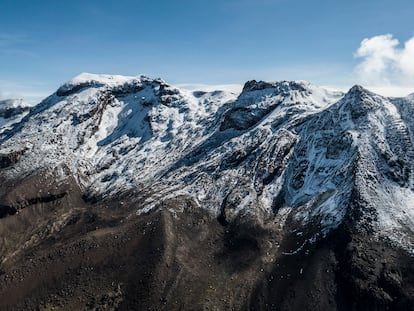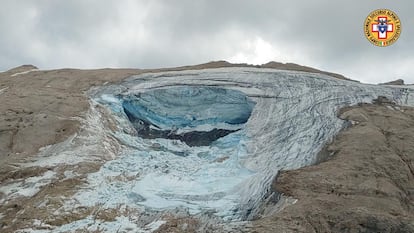Rescuers search for missing climbers after deadly glacier collapse in Italian Alps
The tragedy, which took place on the mountain of Marmolada, the highest in the Dolomites, has killed at least six people and injured another eight
At least six people are dead and eight injured after a glacier collapsed in the Italian Alps on Sunday. The collapse has been blamed on the heatwave gripping Italy, with the warm weather loosening the glacier and causing an avalanche of ice, rock and snow.
Michela Canova, an emergency services spokesperson, told AFP that the avalanche “hit an access path at a time when there were several roped parties, some of whom were swept away.” She said the number of injured “remained a provisional count,” as rescuers continue to search for as many as 17 climbers who could be missing. “The total number of climbers involved is not yet known,” she said. According to Canova, the eight injured climbers have all been transferred to hospital – five to Trento, two to Belluno and one to Treviso.
Four victims were identified on Monday, three of them Italian, including two alpine guides, and another from the Czech Republic, news agency AGI reported, citing rescuers.

The glacier collapsed on the mountain of Marmolada, the highest in the Dolomites, in the eastern Alps, where record high temperatures of 10 degrees Celsius had recently been recorded at an altitude of more than 3,300 meters (10,000 ft).
The situation has caused panic among hikers in the area. According to Italy’s rescue services, 18 people have been evacuated from the summit of Punta Rocca and all hikers at the lowest part of the summit have returned to their place of origin. Reinhold Messner, the first climber to ascend all 14 peaks over 8,000 meters (26,000 ft) above sea level, blamed the tragedy on global warming. “The ice is getting thinner and thinner, and when it falls, pieces break off like skyscrapers,” he said. “Avalanches have always happened, but in the 1960s the danger of them happening was much, much less. Unfortunately, the mountain is also suffering from the pollution of big cities.”
Glaciers and climate change
The Marmolada is the largest glacier in the Dolomites mountain chain and is expected to disappear in 25 to 30 years, or even sooner, if temperatures continue to rise, according to Italy’s National Research Council (CNR). The glacier lost 30% of its volume and 22% of its extension between 2004 and 2015, according to a study by CNR’s Institute of Marine Sciences, in collaboration with several universities.
And the Marmolada glacier is not the only one at risk in Italy. In September 2019, the front of the Planpincieux glacier on the Mont Blanc peak in the Alps began to break loose, putting the populations of the nearby Courmayeur valley on alert. On September 25, 2019, Giuseppe Conte, then Italian prime minister, spoke about the glacier at a UN Assembly and called for action to prevent its disappearance.
Antonio Fosson, the regional head of Italy’s Aosta Valley, which is home to Mont Blanc, has also called for action. He invited all authorities in the country to visit the region and see first hand the effects of global warming. “The Aosta Valley is a laboratory of climate change,” he said. The scientific community welcomed the move, but there was little response from the international community.
The crisis facing Mont Blanc and the surrounding mountains is not new. The first warning signs were seen in the mid-19th century, when the Planpincieux and Rochefort glaciers – which were once joined – started to separate due to rising temperatures. If the average temperature continues to rise, the glaciers will continue to retreat and form at higher elevations, where it is colder. Other glaciers in the area, such as the Seracco Whymper and the Gran Croux, face the same risk.
Tu suscripción se está usando en otro dispositivo
¿Quieres añadir otro usuario a tu suscripción?
Si continúas leyendo en este dispositivo, no se podrá leer en el otro.
FlechaTu suscripción se está usando en otro dispositivo y solo puedes acceder a EL PAÍS desde un dispositivo a la vez.
Si quieres compartir tu cuenta, cambia tu suscripción a la modalidad Premium, así podrás añadir otro usuario. Cada uno accederá con su propia cuenta de email, lo que os permitirá personalizar vuestra experiencia en EL PAÍS.
¿Tienes una suscripción de empresa? Accede aquí para contratar más cuentas.
En el caso de no saber quién está usando tu cuenta, te recomendamos cambiar tu contraseña aquí.
Si decides continuar compartiendo tu cuenta, este mensaje se mostrará en tu dispositivo y en el de la otra persona que está usando tu cuenta de forma indefinida, afectando a tu experiencia de lectura. Puedes consultar aquí los términos y condiciones de la suscripción digital.
More information

The death of the last glaciers in Mexico
Últimas noticias
Most viewed
- Sinaloa Cartel war is taking its toll on Los Chapitos
- Reinhard Genzel, Nobel laureate in physics: ‘One-minute videos will never give you the truth’
- Oona Chaplin: ‘I told James Cameron that I was living in a treehouse and starting a permaculture project with a friend’
- Why the price of coffee has skyrocketed: from Brazilian plantations to specialty coffee houses
- David King, chemist: ‘There are scientists studying how to cool the planet; nobody should stop these experiments from happening’










































